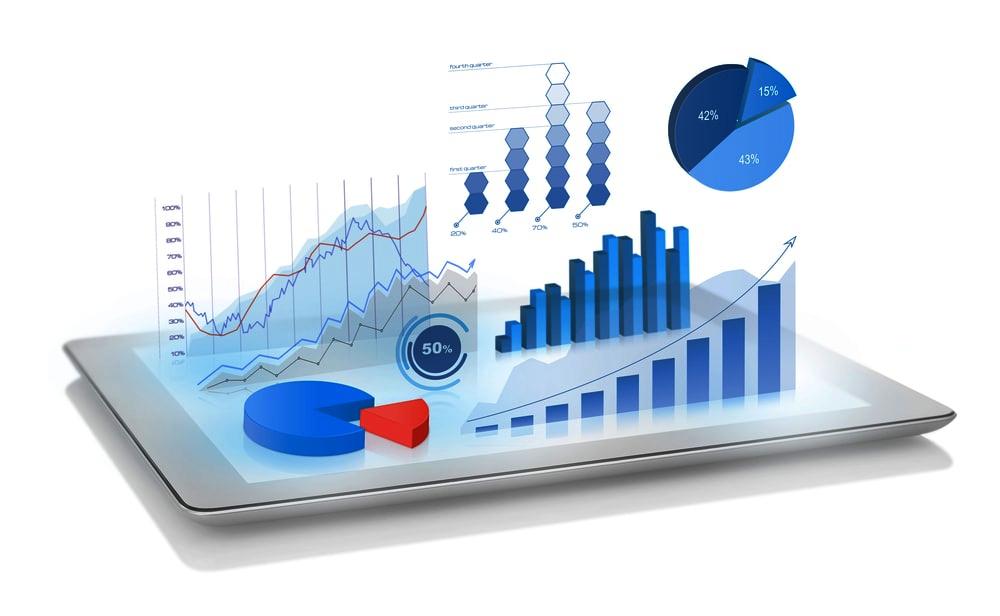You may not know the importance of data visualization until you come across raw data in a spreadsheet or Excel format. You can only stare at the data blankly, hoping that a data analyst does the magic to make processing easier.
Now, this is where data visualization applies. In its simplest definition, data visualization is the process of visually representing raw data in a format that is easy to understand.
The visual formats are charts, pie charts, graphs, Sankey diagram, images, infographics, etc.
Importance of Data Visualization
According to research, the human brain processes images within 13 milliseconds. That’s how fast our brain is. Think about how easy it is for you to notice details from a graph rather than plain data?
For example, you have a spreadsheet with the digital marketing spending for the last 3 months. You now want to find out if you’re making an ROI.
How will you determine this from the raw data? Will you present this to your top management? It’s definitely a no, right? So, what’s the secret?
Now, this is where data visualization applies. It helps to solve complex data problems. In our example above, you can represent the data using a chart or graph.
But that’s not the only importance of data visualization. Let’s find out more below:
1. Visualization helps in data storytelling
Visualization makes it easy to tell a story through data. You can make comparisons faster with visual data. For example, if you were to identify the differences in data for a specified period, it would take you longer to make sense of the data.
But with visualization, you only need to represent the data in a visual format. 90% of data transmitted to our brain is visual.
It is easier for anyone with little business knowledge to understand your business data. Data storytelling makes it versatile. You can use it in videos, brochures, case studies, and social media posts.
2. Data visualization helps in decision-making.
Presenting visual data to the top management helps in making better business decisions. It is easier to identify weaknesses and strengths in graphical data than plain numbers and texts.
For example, you can represent data in an infographic. It gives an overview of complex data by highlighting essential information. The decision-making process is fast and effective as the data is simple to understand.
3. It is easier to communicate data.
The importance of data visualization is that it helps to communicate data. Instead of presenting chunky data, you only represent the essential part of it.
When you’re creating a business strategy, it is easier to communicate facts using visuals. Visualization helps to engage an audience, ask questions, give a review, and make necessary changes.
4. Visualization helps to represent complex data.
Although slightly mentioned earlier, the purpose of visualizing data is to communicate complex data. You can identify the patterns, relationships, and differences based on a visual representation.
For instance, you want to communicate results to the senior management about your research findings. Of course, they are not interested in every detail of the findings.
So, you can use a visualization tool to generate a chart, pie chart, or infographic to communicate specific information.
5. Discover trends and make future predictions
Companies that rely on data need data visualization tools to identify future trends and also make predictions. It’s easier to miss out on important details when dealing with a large amount of data.
By identifying trends, it’s easier to identify issues and prevent future problems. Visualization helps to stay ahead of your competition. That way, you are able to maximize your business profits.
6. Simple to understand
Graphical data is easier to follow as compared to any other form of data. Data in a spreadsheet, for instance, can be hard to understand.
Information on a graph or pie chart is attractive to the eye. It is easier to make conclusions and timely decisions. Data in visual representation conveys a message to an audience faster.
7. It drives engagement
The importance of data visualization, as mentioned earlier, is to help with communication. By engaging your audience with visualized data, it results in different views and opinions.
Visualization drives engagement and the various ideas help to come up with better strategies.
8. It gives you customer insights.
One of the ways businesses manage to maintain their audience is by checking customer data. For example, Google Analytics presents data in a visual format, making it easy for anyone to understand.
It is easier to discover customer data like age, location, and gender. You can pick the information and use it to maintain your customers and create new marketing strategies.
Tips to Using Data Visualization
So far, you can tell that data visualization plays a crucial role in a business. It helps to represent information in a visual format when dealing with complex data.
But, what are the tips for using data visualization?
- Depending on your goals, use the right visuals and colors when dealing with visual formats. For instance, use a heat map when you’re working with two or more variables.
- Keep your visualization simple enough for your audience to understand. Remember, the purpose of using data representation is to communicate effectively to help in decision-making.
- Have your audience in mind. Are you presenting data to people with little business knowledge, decision-makers, or top management?
- Use visualization tools like Tableau or Microsoft Power BI when generating the graphical and pictorial formats.
- Take time when representing data. You do not want to miss out on important information that can help make future predictions.
Final Verdict
And that’s it for the importance of data visualization. Data plays a crucial role in the success of a business. Identifying ways to communicate the data goes a long way in decision-making.
There are various types of data visualization. You can use a heatmap, pie chart, line graph, infographics, or tables to represent data.
Data visualization helps to discover new trends, create relationships, predict future trends and make better decisions. If you’re wondering whether you need data visualization for your business strategy, there you have it. You can now transform data into a simple format that is easy to understand.




















![TamilMV Proxy List Top 30+ [Unblock TamilMV Sites] TamilMV Proxy Unblock](https://technewsgather.com/wp-content/uploads/2023/04/17825836_SL-121019-25870-14-1-100x70.jpg)